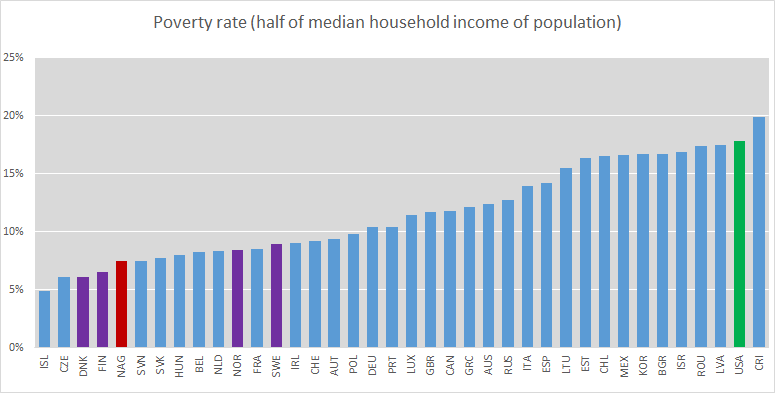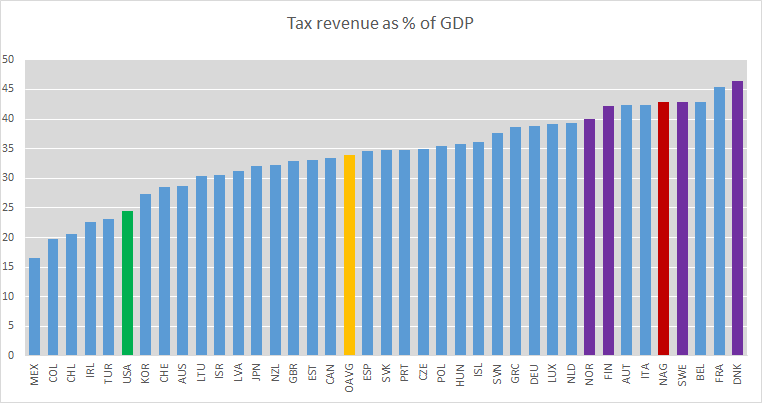Editor’s note: Had to republish since the original post incorrectly contained an earlier draft which had numerous errors. Please refer to this amended post instead. Apologies for that.
I briefly touched on social spending in a post way back comparing France and the US specifically. So here’s a different question: how do the Nordics, that is Sweden, Finland, Denmark, and Norway, compare to the US? Most provide a sufficient window into what kind of spending we should target to at least attain any semblance of social democracy in the US. I personally favor Norway and especially Finland’s social systems, though they all average fairly close together in the aggregate.
The following tables are based on the latest OECD data (all linked in the captions) between 2015 and 2019, and it’s the best we’re going to get for a while until budgets settle after the pandemic. The OECD includes most “western” nations as well as industrializing ones such as Mexico and Turkey. Any expenditures listed are only public spending, not private. Countries of interest are color-coded: the US being green, the OECD average (where provided) orange, all four Nordics purple, and the Nordic average, my own calculation labeled “NAG”, as dark red.
First on the list is social spending:

The US clearly lags behind both the Nordics and several other European nations. We could certainly stand to increase our expenditures by quite a bit. While this doesn’t fully paint the picture since countries like France and Belgium are also near the top (of whom I don’t consider outright social democracies), the Nordics do a fantastic job in obtaining results thanks specifically to their universal welfare states as evidenced by the following poverty and equality metrics:


Income inequality here measures disposable income (gross income including welfare minus taxes)
And they accordingly pay a substantial amount in taxes to get there:

One other effect is the remarkably low infant mortality rates among said nations (well, Denmark is slight outlier for reasons I’m unsure of):

Thus far, this has been the broader overview of some key variables. So what specific pieces of the welfare state do they focus on?

Old age pensions are the one area we don’t do horrible with in comparison. Social security could definitely use a facelift: instituting a minimum pension, scrapping the payroll tax cap, gradually including all public workers, and beefing up the earnings-related pensions a bit. Otherwise, we actually aren’t far off from the Nordics. Ironically, there is a danger in spending too much on pensions, as evidenced by France, Italy, and Greece all the way to the right. Their welfare states historically have operated under what’s called the “continental” or “conservative” that has the unfortunate side effect of a “race to the biggest pension for me” situation due to multiple yet segregated pension plans for different occupations. I may elaborate on this in a future post, but for now, those interested can check out Esping-Andersen’s first chapter in The Three World’s of Welfare Capitalism (free pdf) which provides a nice background differentiating the three types of welfare states. Bottom line: universalism keeps this problem in check.

Arguably the greatest indicator of how equal a nation is and how generous they are is through disability expenditures, e.g. disability pensions, occupational injury compensation, and sick leave. Other datasets reveal the same trend in that genuine social democracies boast large budgets dedicated to the incapacitated, and in this day and age, I believe it sends a clear message on where a country’s priorities lie. The disability portion of social security in the US could stand to be expanded by a substantial amount (scrapping the onerous means testing around it comes first though), and a comprehensive national sick leave program is sorely needed.

Family benefits are wholly inadequate in the US. This is probably the one area that requires the greatest deal of reform outside of healthcare in terms of creating universal child allowances, child care, parental leave, and other benefits like a baby box. The Nordics boast low infant mortality rates for a reason thanks to these stats alone.

Unemployment benefits are meager as well (pre-COVID anyway) due to our sadly incorrect cultural and political attitudes around the unemployed. This data is a bit misleading, however, as the reason some Nordics are low, or zero in the case of Denmark, is that these countries operate off the “Ghent” system. Since unions are so pervasive in these places with most workers either interacting with or being in a union, unions tend to administer unemployment benefits themselves, typically with funds provided by the state as of late. If there was available data on union spending, expenditures would correspondingly be higher.

The US has a rather egalitarian education system compared to other nations as historically our K-12 schooling was a first in the world, and even today over 95% of all American students still go to public school. Our spending levels could be boosted a bit, particularly by subsidizing tertiary education (universities, community colleges, trade schools), but the current distribution of funds is the real issue which is resulting in massive inequalities between school districts.
And finally, of course, the biggest elephant in the room:

For those lost as to why the US seems out of control, check out my very first blog post talking about Medicare-for-All. The short is that the Affordable Care Act made most employer-sponsored health insurance mandatory, effectively converting a ton of originally voluntary private spending into compulsory public expenditures. In any case, this is the one item that could actually be reduced via universal healthcare and cost controls. It would take several years, if not a decade, to achieve this, and even then, we may only fall closer to countries like France and Germany. Either way, healthcare should actually be making up a relatively smaller piece of the pie under more ideal conditions, lobbing off a few points of GDP at the least.
If the US were to expand its welfare state to match roughly the average of the Nordics, we’d be increasing total social expenditures by 8-10%. If we wanted to take the most generous route of each individual country, it would be around 15%. And as much as some socialists hate certain taxes, a great deal of it is paid for via large payroll taxes, a hefty value-added tax, and increased income taxes. The lunch is indeed free at point-of-service, however, society is covering it in the end.